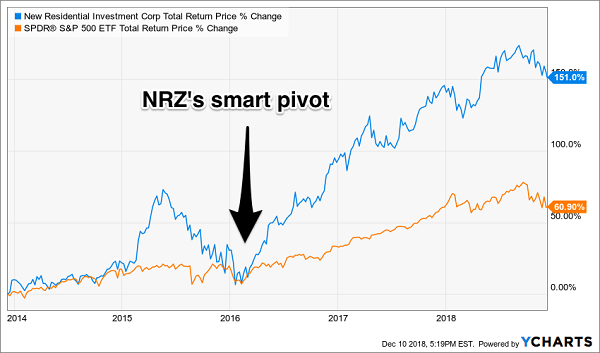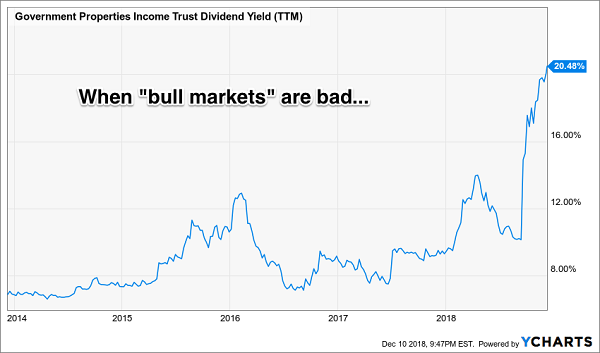As we move nearer to 2019, market sentiment is growing increasingly cautious. And that’s fair enough. Talks of inverted yield curves and the ongoing U.S.-China trade war certainly aren’t boosting sentiment. But even within these conditions, there are still stellar stocks to buy out there.
I mean stocks with strong fundamentals and high growth potential. And the best part is, you don’t even have to look that far to find them. Morgan Stanley has just released a report revealing its stock picks for 2019. They see 2019 as a year of consolidation for the stock market. Consolidated stocks typically trade within limited price ranges and offer relatively few trading opportunities.
However, the names singled out in the report are capable of growing earnings even if the economy slows and the market tumbles.
Here I pinpoint 10 of the firm’s most compelling stock picks. As you will see all 10 stocks boast a “strong buy” analyst consensus rating (according to TipRanks research tools), and their upside potential doesn’t look too bad either. With that in mind, let’s see why Morgan Stanley is such a fan of these stocks right now:
Alphabet (GOOGL)

All’s well that ends well. Alphabet (NASDAQ:GOOG, NASDAQ:GOOGL) may have endured a rocky trading period recently, but the future remains bright according to Morgan Stanley.
“As the dominant player in paid search, Google continues to benefit from secular growth as advertising dollars shift into digital,” the firm’s Brian Nowak (Track Record & Ratings) said.
Most notably, Google also owns YouTube, the leader in online video advertising. Indeed, Novak sees video advertising expanding nearly 25% from 2017 to 2020 to roughly $22 billion in the U.S. alone.
The Street shares this upbeat outlook. With a “strong buy” analyst consensus, the company’s $1,349 average price target speaks of 24% upside potential ahead. Get GOOGL Research Report.
Amazon (AMZN)

Also on Nowak’s stocks-to-buy list: Amazon.com (NASDAQ:AMZN). “As the dominant player in U.S. eCommerce, Amazon continues to experience secular growth as retail dollars shift online,” the analyst explained.
He believes the e-commerce giant has a “significant opportunity” to capture a larger piece of the roughly $1 trillion worldwide eCommerce market (ex China). This is thanks to 1) the company’s growing logistics network and 2) its expanding Prime membership program.
Indeed, an impressive 37 out of 38 analysts covering the stock are bullish. That’s with a $2,154 average price target (27% upside potential). Bear in mind that while GOOGL stock might be struggling, AMZN is still enjoying strong momentum. Shares are up 40% year-to-date. Get the AMZN Research Report.
Expedia (EXPE)

Let’s stay in internet land for our third stock: leading online travel player Expedia Group (NASDAQ:EXPE). Like other web stocks, Expedia continues to benefit from secular growth as travel dollars shift online.
“The $1.3 trillion global travel industry remains a highly fragmented market and both BKNG and EXPE look well positioned given their scale advantages and portfolio of brands” writes Morgan Stanley’s Brian Nowak.
In all, over the next three years he expects EXPE’s bookings to grow at an aggressive 11% CAGR.
Indeed, while some skeptics may call the stock overvalued, the Street is forecasting a 23% rise in share prices for EXPE. That’s with 12 buy ratings vs three hold ratings over the last three months. Get the EXPE Research Report.
Illumina (ILMN)

Genetic sequencing stock Illumina (NASDAQ:ILMN) gets the thumbs up from Morgan Stanley’s Steve Beushaw (Track Record & Ratings). This is a stock that’s already up 55% year-to-date, boosted by the savvy acquisition of Pacific Biosciences in December.
“As the dominant provider of technology to sequence DNA, ILMN stands to benefit from a series of market developments and policy changes that have emerged over the last year,” Beuchaw said.
Here are a few positive catalysts to consider: 1) The success of DNA-driven drug administration in immunotherapy by Merck 2) Stronger global pharma and government funding for DNA analysis 3) Growing consumer interest in DNA-derived applications; and 4) Growing global research funding for genomic research.
In terms of share price, the Street is modelling for 8% upside ahead. This would take this “strong buy” stock to buy to $367. Get the ILMN Research Report.
Intuitive Surgical (ISRG)

Intuitive Surgical (NASDAQ:ISRG) specializes in robots — robotic surgeries to be precise. Its da Vinci robotic system has already racked up a whopping five million procedures. That’s with 44,000 da Vinci surgeons trained worldwide.
“Intuitive Surgical is the leader in robotic surgery,” states the firm’s David Lewis (Track Record & Ratings) said. The system allows doctors to carry out minimally invasive procedures. It does this by translating the surgeon’s hand movements into smaller, precise movements of tiny instruments inside the patient.
Lewis added: “The company has gained significant adoption within urology and gynecology and is still in the relatively early stages of penetration internationally and within broader procedures (including general surgery).”
With eight buy ratings vs two hold ratings, analysts forecast 24% upside for shares. Get the ISRG Research Report.
National Vision Holdings (EYE)

National Vision Holdings (NASDAQ:EYE) is one of the largest and fastest-growing optical retailers in the U.S. It already boasts 1,000 stores in over 40 states.
“We believe EYE offers a unique blend of defensiveness and growth vis-à-vis its focus on value within the non-cyclical optical retail segment and ~50% unit growth runway,” Morgan Stanley’s Simeon Gutman (Track Record & Ratings) said.
The numbers speak for themselves. As Gutman points out, “EYE has delivered 67 consecutive quarters of positive SSS [same store sales] and is expected to grow square footage ~10% annually over the next several years.”
Plus the upside potential looks very compelling. Analysts see shares exploding by nearly 50% to $49. Get the EYE Research Report.
Palo Alto (PANW)

This cybersecurity stock is primed for success. So says Keith Weiss (Track Record & Ratings). He sees Palo Alto Networks (NYSE:PANW) as well-positioned for future industry trends.
“To garner more effectiveness and efficiency in information security architectures, we believe the key secular trend in security will be the consolidation of spending towards integrated security platforms” revealed this five-star analyst.
And Weiss believes PANW can emerge victorious: “Palo Alto Networks stands well positioned to excel within that trend given its leadership in core network security and growing traction into areas such as Endpoint, Cloud, and Security Analytics.”
Encouragingly, its $240 average price target suggests 24% upside potential for this “strong buy” stock. Get the PANW Research Report.
Pluralsight (PS)

Despite what its name might suggest, this isn’t another vision-related stock. Pluralsight (NASDAQ:PS) is an online education company that provides IT and software video training courses through its website. The company is seeing “exceptional” business-to-business activity, with Q3 with billings growth over 50%.
“We believe Pluralsight is well positioned to help enterprises address the need for IT knowledge while managing an accelerating industry-wide talent gap,” commented Brian Essex (Track Record & Ratings).
He continues, “The platform is driven by machine learning technology that not only enables a more efficient learning process at the individual level but also enables enterprises to efficiently quantify, develop, and manage talent across technology platforms.”
Five analysts have rated the stock in the last three months. All named it a stock to buy. They see 30% upside potential ahead. Get the PS Research Report.
Vertex Pharmaceuticals (VRTX)

Vertex Pharmaceuticals (NASDAQ:VRTX) is a biotech that focuses primarily on cystic fibrosis (CF). Word on the Street: This is a stock with some of the best growth prospects in large-cap biotech.
“The company’s CF therapies Kalydeco and Orkambi collectively generated ~$2.2B in sales in 2017, and a third therapy (Symdeko) was approved in early 2018, which we believe could generate ~$750M in sales for 2018E” comments Morgan Stanley’s Matthew Harrison.
Plus Vertex is also developing a triple combination therapy for cystic fibrosis. According to Harrison, this triple therapy has generated strong late-stage data and “could address a large portion of the CF market.”
In total, 12 out of 13 analysts rate this “strong buy” stock a buy, with 17% upside potential from current levels. Get the VRTX Research Report.
Visa (V)

Last but not least we have financial giant Visa (NYSE:V). Trends are looking strong going into 2019.
“Visa is a key beneficiary of robust consumer spending worldwide, the ongoing migration from cash to electronic payments, and broadening merchant acceptance,” sums up Morgan Stanley analyst James Faucette.
This should power the stock higher despite forex headwinds.
“Global Personal Consumption Expenditure and secular growth drivers should support high-single-digit volume growth and low double-digit revenue growth in the near-to-medium term” he adds. Europe, India and Visa Direct are all potential upside drivers.
All told, 15 analysts rate this a stock to buy with only two analysts staying sidelined. Their average price target indicates 19% upside potential. Get the V Research Report.
This ‘Overlooked’ Sector Produced the Biggest Winners of the Last Decade
Wall Street is oblivious to it, yet you can earn 2,537% profits from an overlooked "blue chip" sector. The same group of stocks that has produced some of the biggest winners of the last 10 years.
Investors have earned 618%, 834%, and up to 2,500% - performing better than Amazon, Netflix and Facebook.
Click here to get in on your own 2,537% windfall.
Source: Investor Place






